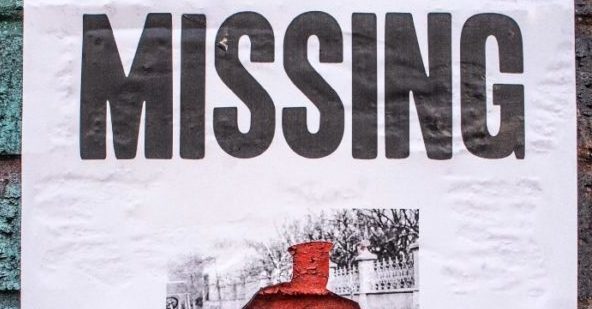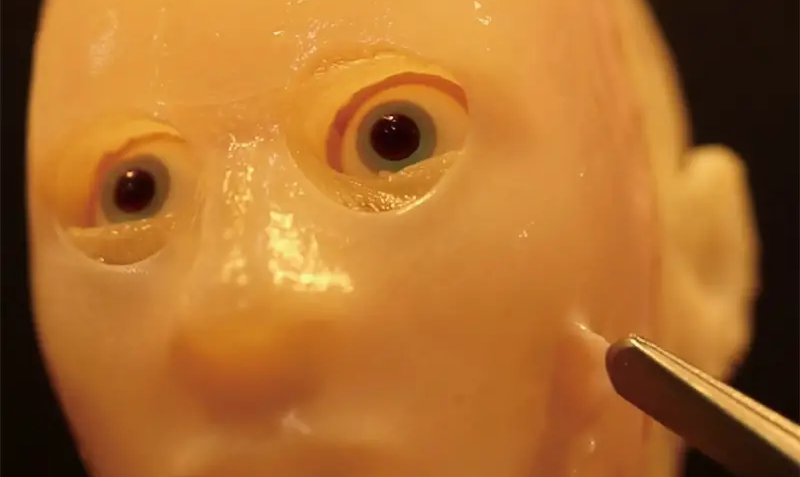On average, 90,000 people are missing in the United States at any given time.
Recently, in preparation to be interviewed on a podcast surrounding the topic of the isolated staircases that have been popping up in national forests around the world, I decided to do a little more research on strange occurrences in the woods. In doing so, I came across David Paulides, a former police detective who is now a researcher and writer known primarily for his self-published books surrounding the mysterious disappearances of people in national parks and elsewhere. This led me down a bit of a rabbit-hole that I’m delighted to have explored.
This article was originally published on Medium.com.
In his book series, Missing 411, Paulides attributes mysterious and unspecified causes to these disappearances. According to Paulides, he began researching the topic when he was doing research in a national park and came across an off-duty park ranger who expressed concern surrounding the questionable nature of some of the missing person cases which occurred in the parks.
Asked to research the issue for himself, Paulides asserts that he began to uncover multiple lines of evidence that suggested negligence on the part of the park service in their failure to locate the missing people. At this time, Paulides extended his investigation to include missing person cases from around the world, leading to his own conclusion that he had uncovered a mysterious series of worldwide disappearances that defied all logical explanation.
Since coming across Paulides’ work, I was compelled to order one of his Missing 411 books to read more about these mysterious cases for myself. If you’re interested in the subject, I’d encourage you to check out Paul’s website where you can order his series of books for yourself.
There’s something else that Paulides’ work inspired in me, though. I began to wonder if there were certain hotspots for missing person cases. In his work, Paulides seems to have drawn the conclusion that there is something sinister at work in national forests around the globe and that the governments of the world know what’s going on and are trying to keep it hidden. I began to wonder whether or not, outside of national forests, there were other locations known for large numbers of missing person cases. Further, could it be that these locations are hotspots because there are yet undiscovered links between the cases?
With these questions, I set out to do a little bit of research.
“It has been reported that, on average, there are 90,000 people missing in the United States at any given time.”- USA Today
The easiest place to start on my search for hotspots for missing person cases seemed to be with states. Recently, the Huffington Post provided data on the topic of which states had the highest number of missing person cases. In this post, I’ll be focusing on the top 5 states with the highest number of missing persons cases per 100,000 people.
Alaska
On average, Alaska has a total of 10 missing people per every 100,000 people. At first glance, it seems to make a lot of sense that Alaska would be at the top of the list. After all, Alaska is filled with a vast amount of wilderness. That being said, Alaska has a rate of missing persons that is almost two times the national average.
Chillingly, Alaska also holds the record for the highest number of missing people who are never found. One particular part of the state, in fact, has been popularly compared to the Bermuda Triangle because people seem to vanish there at an alarmingly high rate.
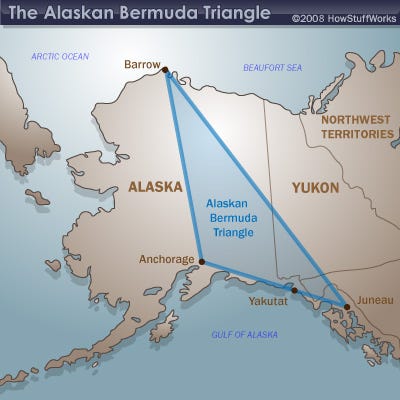
Image Source: HowStuffWorks.com
In this part of the state, highlighted in the image above, hikers go missing, planes go down, and Alaskan tourists and residents alike seem to vanish into thin air. This so-called Alaskan Bermuda Triangle extends through four of the state’s regions, starting at the southeastern wilderness and running through the interior tundra before extending up to the arctic mountain ranges.
The native Alaskan Tlingit Indians who live near Juneau have even incorporated this particular area into their religious culture. It is their belief that an evil spirit by the name of Kushtaka, who is said to be a cross between an otter and a man, captures the spirits of people that have drowned or gotten lost, taking them away to a realm that is unseen by man.
In the year 2007, Alaska state troopers added a total of 2,833 missing person notices to their Missing Persons Clearinghouse which maintains all related information. Considering the state had just over 670,000 residents at the time, this figure averages out to about 4 in every 1,000 people.
One of the most interesting cases of a missing person in Alaska that I found when researching the topic is the story of Michael LeMaitre, a 65-year-old man, who participated in Alaska’s annual Mount Marathon race on July 4, 2012. This race was around 3.5 miles long and the runner’s route went partially up Mount Marathon and back.
The winner of this race completed their run in under 45 minutes, and it was noted by many that LeMaitre was still struggling to make his way to the top three hours after the start of the race. On this particular day, the weather was cold and wet but it was determined by race officials that he was progressing steadily. Drawing this conclusion, the call was made that they would wait for LeMaitre toward the finish line. Unfortunately, he was never seen again.
After a total of six hours, LeMaitre still hadn’t made his way to the finish line and a search began. With no results turning up upon the initial search for LeMaitre, the Alaska National Guard was called in with a helicopter. Still, they turned up no sign of LeMaitre. Weeks of searching ensued and, simultaneously, locals were beginning to come up with a variety of theories concerning the disappearance of Michael LeMaitre.
LeMaitre’s daughter, MaryAnne, who continued to walk Mount Marathon for weeks looking for him, has her own ideas about what could have happened to her father:
“The biggest factor was the record snow — the trail conditions were unlike anything they had seen before — ice underneath. The chutes had snow bridges on them that have been collapsing all summer. If my dad had fallen in one of those chutes and a snow bridge had collapsed over him, the infrared helicopters wouldn’t have been able to find him.”
To this day, LeMaitre’s whereabouts are completely unknown. He was officially declared dead in August 2012 after a presumptive death hearing.

Michael LeMaitre. Image Source: TrueCrimeSociety.com
Arizona
Joining Alaska as having more than 10 open missing persons cases per 100,000 people is Arizona. Missing persons cases are so common in Arizona, in fact, that the state even has its own Missing in Arizona Day which is a day focused around the effort to try and help families who are desperately looking for their missing loved ones.
According to the National Missing and Unidentified Persons System, Arizona is the top state in the United States for open missing persons cases. In fact, there are currently about 700 cases of missing people in Phoenix, Arizona alone.
One story that I found when researching missing people in Arizona details the case of Mikelle Biggs, an 11-year-old girl who disappeared on January 2, 1999 while she was waiting for an ice cream truck. It is said that Mikelle could hear the music coming from the ice cream truck and waited so she could buy her favorite treat- a gumball popsicle. She was riding her 9-year-old sister’s bike in circles at her street’s T-intersection. Because it was getting pretty dark, Mikelle’s mother told Mikelle’s sister, Kimber, to tell her to come back inside the house.
When Kimber went outside to retrieve her sister, however, all she found was her bike on the ground with the wheels still spinning. Nearby, the two quarters that Mikelle had been holding for the popsicle were lying in the street. Obviously, a massive search ensued. Surprisingly, while over 800 pieces of evidence were collected and a total of 10,000 tips were received by police, no solid evidence of what happened to the little girl has ever been found. Further, no potential suspects have ever been identified. She was never seen again.
In 2018, renewed interest in Mikelle’s case prompted officials to release an age-progressed photo of the 11-year-old. Police were tipped off to a dollar bill that had been discovered with the words, “My name is Mikel Biggs kidnapped from Mesa AZ I’m Alive,” written on it. Although the name was misspelled, police reported that they were looking into the validity of the discovery. The age-progressed photo presents what Mikelle would look like at age 25.

Age-progressed photo of Mikelle Biggs. Image Source: ABC15 Arizona
Oregon
Similarly to Alaska, Oregon is well-known for its vast wilderness and high mountain ranges. Unfortunately, it has another thing in common with the state of Alaska: the state’s high number of missing person cases. According to David Paulides, this includes a “ridiculous” number of missing children. As part of his research, Paulides has mapped out clusters of vanishings in forests and state parks in Oregon.
One particular hotspot for missing people in the state of Oregon is Crater Lake, located in the Cascade Range of Southwest Oregon. The lake is made up of pure rainwater lying in the crater of a now dormant volcano and the area is well-known for its bizarre disappearances. According to Paulides, there is a notable connection between bizarre missing person cases in the United States and nearby bodies of water such as lakes or rivers.
One popular case connected with the infamous Crater Lake is that of Samuel Boehlke, an 8-year-old boy who went missing on October 14, 2006. Samuel had mild autism and is reported to have walked away from his father at a scenic overlook at Crater Lake, taking off into the forest. The boy has never been seen since.
According to Paulides, there is something about the case of Samuel Boehlke that just doesn’t add up. In regards to this particular case, he has said:
“The circumstances behind his disappearance and the subsequent inability of the park service to find him is unusual. They brought in canines, canines couldn’t pick up the scent. They brought in air support, they couldn’t find him. A multi, multi-day search couldn’t locate the boy.”
Bizarrely, eight years before the disappearance of little Samuel Boehlke, another 8-year-old boy named Derrick Engebretson vanished from a spot very close to the last known location of Samuel. He has never been seen again either.
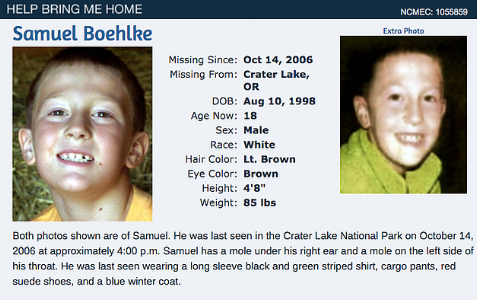
Samuel Boehlke. Image Source: StrangeOutdoors.com
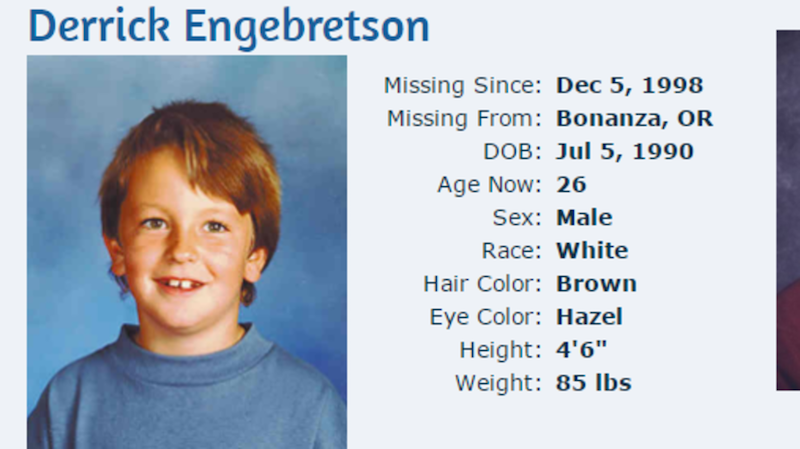
Derrick Engebretson. Image Source: Katu.com
Washington
You may be starting to notice a trend here when it comes to hotspots for missing person cases in the United States: many of the top-ranking states are located in the Northwest. Washington has been categorized by the Huffington Post as having between 5 and 7 missing persons for every 100,000 people in the state. According to the National Missing and Unidentified Persons System, there are currently 643 open missing person cases in the state of Washington.
One particularly interesting case in the state of Washington is that of Heather Higgins, a South Spokane resident. She was 39-years-old when last seen on September 20, 2010. She was seen leaving her apartment with a friend. Later in the day, when Higgins’ mother couldn’t reach her by phone, she went to her home only to find nothing out of the ordinary. When the friend that Higgins was seen leaving with earlier in the day was questioned, he said that he had dropped her back home after they ran some errands together.
When asked whether or not Higgins would purposely disappear, her mother stated that she would never intentionally leave her cats behind. For months after the disappearance of her daughter, Higgins’ mother would often fall asleep with a cordless phone in her hand, hoping to hear from Heather. Although the detectives working the case have had leads over the course of their investigation, the case still remains unsolved to this day and nobody knows what happened to Heather.

Heather Higgins. Image Source: MissingIn.org
Nevada
Finally, the fifth missing person cases hotspot we’ll be discussing is the state of Nevada. People are known to frequently go missing in big cities and remote areas alike in Nevada and in Las Vegas alone, it is reported that between 60–80 people go missing every weekend. Similarly to Alaska, Nevada is known for a particular location known popularly as the Nevada Triangle. This desert area has been the location of the vanishing of 2,000 planes over the course of 50 years- some to never be found.
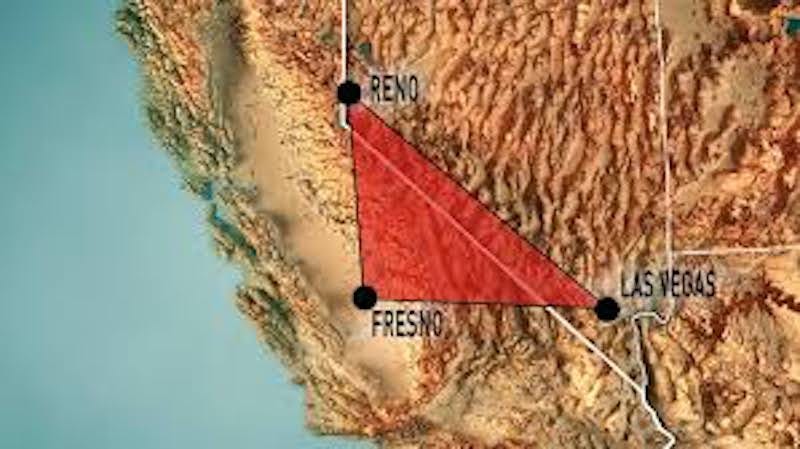
The Nevada Triangle. Image Source: MyNews4.com
Typically, the Nevada Triangle is defined as spanning left from Las Vegas in the southeast to Fresno in the west before connecting back to Nevada at the top. Interestingly, within this triangle filled with rugged wilderness, is the top-secret and mysterious Area 51.
On September 3, 2007, Steve Fossett was piloting a plane that went missing in the Nevada Triangle. Fossett was said to be an experienced pilot and adventurer, making his disappearance all the more bizarre. Fossett was flying a single-engine Bellanca Super Decathlon over Nevada’s Great Basin Desert and never returned. A search that lasted nearly a month ensued but nothing turned up and the search was ultimately called off on February 15, 2008 with Fossett being declared dead.
Chillingly, later that year on September 29th, Fossett’s identification cards were discovered in the Sierra Nevada Mountains in California by a hiker. It was then, a few days later, when the crash site was discovered. It should be noted that the location of the crash was a total of 65 miles from where Fossett originally took off. Half a mile from the scene of the crash, two bones were recovered that were found to belong to Fossett.
In another unexplained incident, Steven Koecher, aged 30, disappeared in the city of Henderson, Nevada in 2009 under very mysterious circumstances. Koecher had recently relocated from Utah and his car was found abandoned on a suburban dead-end street. The last time that Koecher was seen alive was captured by a neighbor’s security camera on December 13, 2009 and he can be seen in the black-and-white video walking down the sidewalk before crossing the street.
While there have been theories to suggest that Koecher disappeared of his own accord, it should be noted that he purchased Christmas presents for his family the day before he was captured on camera walking away. The presents were located by investigators, wrapped and in the backseat of his abandoned car. They also located a pile of resumes, blankets, pillows, and a shaving kit.
Interestingly, some activity was recorded on Koecher’s cellphone over the next two days after his disappearance. The reason for Koecher’s traveling to the Las Vegas area on the day of his disappearance has never been determined, although his family believes he may have been looking for work as he couldn’t make the full rent payments on his apartment with the job that he had. That being said, searches around the area returned no evidence.
In another bizarre detail of this case, it was found that Koecher had been driving great distances around Utah and Nevada in the week prior to his disappearance, including almost 1,100 miles in a single day. This information was gathered through credit card and cell phone receipts, as well as witness statements. The purpose of these long drives are still entirely unknown, although it has been determined that on one trip he visited a former girlfriend’s parents and had lunch at their house.
There are many theories regarding the disappearance of Steven Koecher but investigators seem to have hit a brick wall in their investigation. Koecher’s family has their own theories about what may have happened to him, but remain perplexed. When asked, one family member voiced their confusion, saying:
“We’ve considered every possibility. But each possibility has a contradiction. Is it plausible that someone is walking down the street and then suddenly they’ve vanished? All clues are consistent with that, but that’s not possible.” — Rolf Koecher
Where Did Everyone Go?
In researching each of these states and reading about each of these cases, I find myself wondering and coming up with a number of possible theories for each of the cases. Still, these are just theories and there is little evidence of what happened in any of these cases. Worst of all, this is just a glimpse of the thousands of missing person cases that remain open in the United States. Every day, someone simply vanishes into thin air, and tracking down leads in an attempt to secure evidence of what happened to them proves a fruitless effort in many cases. In any number of these cases, you can’t help but wonder if there’s some link, if there’s some greater nefarious force at work in these disappearances.
One thing that we don’t talk about enough in this country is the outrageously, terrifyingly high rates of human trafficking. I can’t help but feel that this may be what’s behind so many of the missing person cases in our country today- particularly in the case of children. A common misconception about human trafficking is that it simply doesn’t exist in the United States. This is entirely false. In fact, the United States is ranked one of the worst countries in the world for human trafficking, with an estimated 199,000 incidents occurring within the country each year.
According to the World Population Review:
“In 2019, the United States had 11,500 human trafficking cases reported. The most common type of trafficking was sex trafficking (8,248 reports), with the most common venues being illicit massage/spa businesses and pornography.”
That being said, there is also the matter of so many people going missing in specific locations in the country. These locations are hotbeds for disappearances and this has been largely unexplained or even widely talked about, leading researchers like David Paulides to try to uncover the truth. While the federal government does not track the number of missing persons in national parks (for reasons I don’t understand), experts believe that about “1,600 people mysteriously vanish each year while visiting parks throughout the United States. While many reported missing are found, it is estimated that hundreds remain missing.”
Further, there are hundreds of stories of bizarre, unexplained, and possibly paranormal activity surrounding these disappearances in national forests, something Paulides details in his research. It makes you wonder whether something we can’t explain is to blame for the outrageous number of disappearances in these locations, largely going without media coverage.
Further, Paulides has reported to receive very little help from government agencies with some even seemingly attempting to halt his investigations. Is there something the government knows about these disappearances and is desperate to keep under wraps?
I don’t know what to think.
For now, all we can do is research, stay informed, and be wary.

